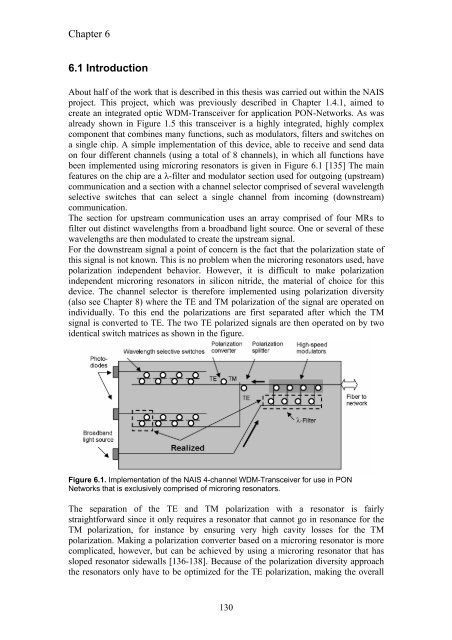Edwin Jan Klein - Universiteit Twente
Edwin Jan Klein - Universiteit Twente
Edwin Jan Klein - Universiteit Twente
You also want an ePaper? Increase the reach of your titles
YUMPU automatically turns print PDFs into web optimized ePapers that Google loves.
Chapter 6<br />
6.1 Introduction<br />
About half of the work that is described in this thesis was carried out within the NAIS<br />
project. This project, which was previously described in Chapter 1.4.1, aimed to<br />
create an integrated optic WDM-Transceiver for application PON-Networks. As was<br />
already shown in Figure 1.5 this transceiver is a highly integrated, highly complex<br />
component that combines many functions, such as modulators, filters and switches on<br />
a single chip. A simple implementation of this device, able to receive and send data<br />
on four different channels (using a total of 8 channels), in which all functions have<br />
been implemented using microring resonators is given in Figure 6.1 [135] The main<br />
features on the chip are a λ-filter and modulator section used for outgoing (upstream)<br />
communication and a section with a channel selector comprised of several wavelength<br />
selective switches that can select a single channel from incoming (downstream)<br />
communication.<br />
The section for upstream communication uses an array comprised of four MRs to<br />
filter out distinct wavelengths from a broadband light source. One or several of these<br />
wavelengths are then modulated to create the upstream signal.<br />
For the downstream signal a point of concern is the fact that the polarization state of<br />
this signal is not known. This is no problem when the microring resonators used, have<br />
polarization independent behavior. However, it is difficult to make polarization<br />
independent microring resonators in silicon nitride, the material of choice for this<br />
device. The channel selector is therefore implemented using polarization diversity<br />
(also see Chapter 8) where the TE and TM polarization of the signal are operated on<br />
individually. To this end the polarizations are first separated after which the TM<br />
signal is converted to TE. The two TE polarized signals are then operated on by two<br />
identical switch matrices as shown in the figure.<br />
Figure 6.1. Implementation of the NAIS 4-channel WDM-Transceiver for use in PON<br />
Networks that is exclusively comprised of microring resonators.<br />
The separation of the TE and TM polarization with a resonator is fairly<br />
straightforward since it only requires a resonator that cannot go in resonance for the<br />
TM polarization, for instance by ensuring very high cavity losses for the TM<br />
polarization. Making a polarization converter based on a microring resonator is more<br />
complicated, however, but can be achieved by using a microring resonator that has<br />
sloped resonator sidewalls [136-138]. Because of the polarization diversity approach<br />
the resonators only have to be optimized for the TE polarization, making the overall<br />
130















